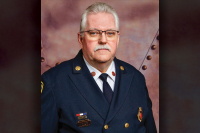Behind the scenes: The logistics of running an international folk festival
By Marian Larson • Contributing Writer
So you’ve been to several of the performances, shopped for souvenirs, even hung out with some of the dancers? Here are a few things you still may not know about the behind-the-scenes side to Folkmoot USA.
Feeding the masses
In order to perform at their best, Folkmoot dancers, staff, and volunteers need fuel — and plenty of it.
Food service director Cathy Reece estimates that 1,600 meals are served daily during the two-week long festival — more than 20,000 in all. Along with her staff of 13, Reece helps to prepare breakfast, lunch, dinner, and a late-night meal, which is served at 11 p.m. after dancers return from their evening performances.
“Everyone is well taken care of in the cafeteria. They get some really nice meals,” Reece said.
A typical breakfast might include eggs, toast, bacon, cereal, fresh fruit, and yogurt. Lunch may be hamburgers and french fries, with a complete salad bar and fruit bar. For dinner they can expect choices such as chicken stir fry, rice and fresh vegetables. The late-night meal could be taco salad, with all the fixings.
Related Items
For dancers with special dietary needs, such as more rice or vegetarian options, the food service staff caters to them as well.
Everyone has plenty of drink options — juice, milk, water, coffee, tea, and soft drinks. Reece even tries to offer some sweets such as pudding, cakes, and brownies for people to enjoy.
“The other day, we baked 1,675 cookies,” she laughed.
All but three of this year’s food service staff are employed by the Haywood County Schools. Reece has worked in food service at Waynesville Middle School and with Folkmoot for the past 21 years.
And though she’s in the kitchen for 14 hours a day, the fact that she and her staff enjoy the work makes it all worthwhile.
“Everyone here gets along so well and has a good attitude. The main thing is that everyone is working together. Without that, we could not get the job done.”
Don’t be late
The biggest challenge is simply in the numbers.
With seven full-time bus drivers and 11 Folkmoot groups this year, transporting the dancers to the correct venues on time sounds like a logistical nightmare.
For Marion Ferguson, Folkmoot’s transportation director, the key is to be organized but still be able to roll with the punches.
“We have a schedule that we follow, and our backup drivers are always willing to help us out,” he said.
Folkmoot uses the Haywood County School System activity buses to transport the dancers. Ferguson is responsible for keeping a close eye on the buses in case of any maintenance issues.
“The school system takes care of maintenance, but sometimes I can do it if it’s a quick fix,” he said.
Though this is his first year as transportation director, Ferguson has driven for Folkmoot since 1986. His wife is also a driver, and his children, ages 4 and 10, spend most of the two weeks of Folkmoot at the Friendship Center with them.
He uses his vacation time from his full-time job as the Instant Management Assistance Patrol, or IMAP, supervisor with the Department of Transportation, to work with Folkmoot. The mix of people — staff, volunteers, and dancers — is what keeps drawing him.
“Everybody grows into one family here in two weeks. It’s amazing to me, even after all of these years, you have all these people from different countries that make friends with each other. They can’t speak a word of the other’s language, but they still learn to communicate,” he said.
Lights, camera, action!
Most audience members enjoying a beautiful Folkmoot performance probably aren’t thinking much about what’s going on backstage.
But what is happening behind that curtain is arguably the most important part of the entire festival. Without good lighting, proper sound, and organized stage-managing, the performances would not draw the crowds that have kept Folkmoot going for 23 years.
Much of a Folkmoot performance is orchestrated by its own people. At larger venues, Folkmoot tries to use the venue’s house sound and lighting, though the emcees, ushers, and ticketing staff are all festival staff or volunteers. For smaller venues, Folkmoot brings its own sound technician.
“I think the average person would be astounded to know how much we really do. We can literally do it all,” said Jamye Cooper, executive director.
When the Folkmoot crew arrives at a location to set up, they get a feel for the backstage area and conduct sound and lighting checks. Guides stay busy providing descriptions of the dances to the stage managers, in case of any special seating or microphone placement. Stage managers communicate those and any other details to the emcee for the evening.
“Every night is different, so stage managing varies by venue,” said Sarah Keener, assistant to the executive director. “It’s about making the shows run smoothly.”









